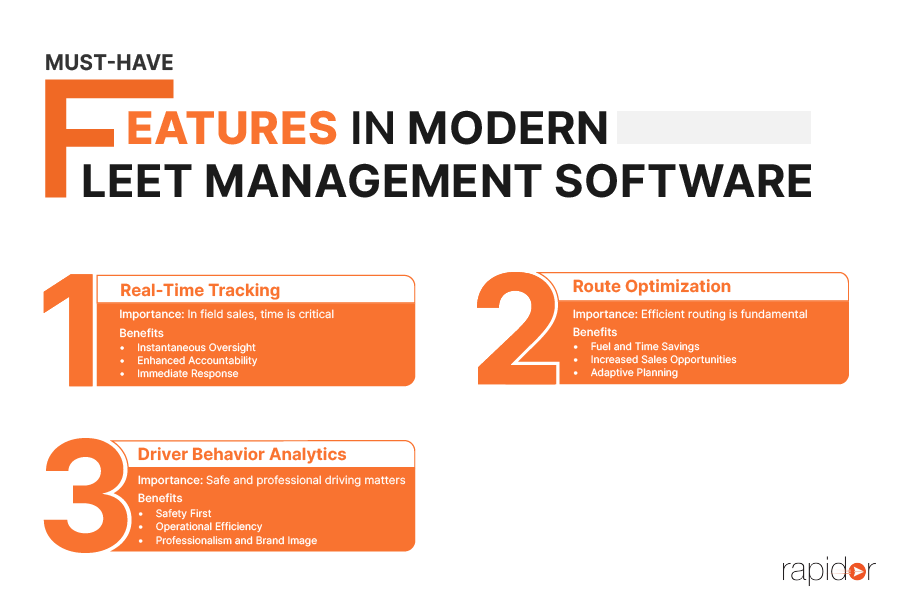In today’s dynamic business landscape field sales management plays a pivotal role in driving growth and capturing market share.
This direct approach allows businesses to interact with their potential customers in real-time, building trust and understanding their needs firsthand. However, field sales management isn’t without its intricacies and challenges.
The complexities involved are many. Imagine having to coordinate the movement of hundreds of sales representatives scattered across different locations, ensuring they reach their destinations on time and follow the most efficient routes.
Throw in variables like traffic patterns, vehicle breakdowns, and unpredictable customer behaviour, and the logistical aspects alone can be daunting. This doesn’t even touch upon the administrative challenges: maintaining records, managing expenses, and ensuring sales targets are met.
It’s against this backdrop that fleet management software began its evolution. Initially it was designed as a simple tool to keep tabs on vehicles. But modern fleet management systems have metamorphosed into comprehensive solutions that address every pain point associated with field sales management.
We will explore the relevance of fleet management software in detail in this guide.
Why did Fleet Management Software Evolve?
The genesis of fleet management software was relatively modest. Early iterations focused on basic GPS tracking, offering businesses a bird’s eye view of their fleet’s locations.
This was revolutionary at the time, giving managers an unprecedented level of oversight and control.
But as the demands of field sales management grew more intricate, so too did the solutions designed to tackle them. Integration of real-time tracking ensured that fleet managers could monitor vehicle movements as they happened, allowing for instant decision-making in response to unexpected challenges.
Hence, it was instrumental in mitigating the effects of unforeseen events like sudden road closures or vehicle malfunctions.
Yet, the real game-changer came with the introduction of route optimization algorithms. Instead of sales representatives relying on instinct or outdated maps, they now had dynamic routing systems that could calculate the quickest, most fuel-efficient paths in real-time.
It reduced fuel consumption and wear-and-tear on vehicles, while ensuring that more customer locations could be covered in a day, enhancing sales opportunities.
The latest advances in fleet management software also bring driver behaviour analytics into the mix. By monitoring driving patterns, these systems can identify and alert managers to any risky behaviours, ensuring safety and compliance with road rules.
Over time, this data can be used to train drivers better and even predict and prevent potential issues before they arise.
What does the Journey from Manual Logs to Software Solutions Look Like?
In the realm of field sales management, the transition from manual logs to sophisticated fleet management software has been nothing short of transformative. This journey not only chronicles the advancements in technology but also mirrors the changing dynamics of the sales and distribution sectors.
How is Pen and Paper Different from Pixels?
There was a time when everything was recorded on paper. Sales representatives would start their day picking up a clipboard loaded with the day’s tasks, locations, and routes.
Each visit, sale, or incident was diligently noted down by hand. At the end of the day, these logs would be handed over to a supervisor or entered into a ledger.
While this manual method had its charm, it was riddled with inefficiencies. Errors in logging, misplacements of crucial notes, or even the simple wear and tear of paper led to a loss of crucial information.
Moreover, reacting to real-time challenges, like a change in the day’s schedule or route, was cumbersome and slow. The lack of real-time tracking meant that managers were often in the dark about the exact location or status of their sales representatives.
This resulted in missed opportunities and inefficient resource allocation.
What does the Digital Revolution Look Like?
As the digital wave began to permeate industries worldwide, the field sales management sector too felt its influence. Early digital tools were simple databases that allowed for more organised record-keeping.
But as technology progressed, so did the capabilities of these tools.
The birth of fleet management software marked a turning point. Sales managers could now have an aerial view of their entire fleet, monitor routes, and even communicate with their representatives on the go.
This initial digital transition was a massive boost to operational efficiency, reducing errors and ensuring more accurate data recording.
How to Look Beyond Tracking?
However, the real evolution came when these digital solutions started offering more than just basic tracking. Route optimization algorithms, integrated into the software, ensured that sales representatives always took the most efficient path, saving time and resources.
The introduction of driver behaviour analytics meant that managers could ensure the safety and efficiency of their fleet by monitoring and analysing driving patterns.
These sophisticated software solutions also began offering insights, predictive analytics, and actionable recommendations. Instead of just recording data, these tools started aiding decision-making, offering insights that could transform strategies and lead to tangible business growth.
What is the Impact of Fleet Management Software on Field Sales?
As the business landscape continues to evolve at a breakneck pace, the importance of timely and efficient field sales operations can’t be overstated.
Companies are increasingly realising that to stay ahead, they must leverage the latest technological advancements. At the forefront of this realisation is the adoption of fleet management software.
This has revolutionised the field sales sector in more ways than one.
How to Optimise Routes and Maximise Efficiency?
One of the primary ways fleet management software has transformed field sales operations is through route optimization. In the past, sales representatives would often rely on conventional maps or local knowledge to navigate their territories.
This approach, while functional, was fraught with inefficiencies. Unpredictable traffic snarls, unexpected road closures, or even sub-optimal route choices could mean the difference between a successful sale and a missed opportunity.
With fleet management software, these concerns are largely alleviated. Advanced algorithms assess multiple variables in real-time, offering the most efficient route options.
This not only ensures timely client visits but also reduces fuel consumption and minimises wear and tear on vehicles.
The result? A more streamlined operation that enhances both profitability and customer satisfaction.
How Crucial is Real-time Oversight and Dynamic Decision Making?
The introduction of real-time tracking in fleet management software has brought about a paradigm shift in managerial oversight. Instead of waiting for end-of-day reports or periodic check-ins, sales managers can now monitor the movements and activities of their representatives in real-time.
This real-time visibility allows for dynamic decision-making. If a client meeting ends earlier than expected, the software can instantly recalibrate and suggest another nearby client to visit.
As a result, it ensures optimal utilisation of the sales representative’s time. Similarly, if there’s a sudden change in the schedule or an unexpected delay, adjustments can be made on-the-fly, preventing potential disruptions.
How does Driver Behavior Impact Sales?
While often overlooked, the behaviour of a sales representative on the road can significantly impact the company’s reputation and the outcome of sales meetings. Driver behaviour analytics, a cutting-edge feature of modern fleet management software, offers insights into how representatives drive.
By monitoring aspects like speed, braking patterns, and idle times, the software can identify potential areas of concern. Such analytics not only ensure the safety of the sales representatives but also reflect the company’s commitment to professionalism and ethics.

What are Some Must-Have Features in Modern Fleet Management Software?
The rapid evolution of fleet management software has given rise to a plethora of features designed to streamline and optimise field sales operations.
As the demands of the industry grow more sophisticated, it’s imperative for businesses to invest in software solutions equipped with the latest functionalities. If you’re in the market for such a solution, here are the must-have features you should look out for:
How Vital is Real-Time Tracking?
Importance
In the fast-paced world of field sales, every minute counts. Real-time tracking provides an instantaneous view of your fleet’s whereabouts, ensuring that you’re always in the loop.
Benefits
- Instantaneous Oversight
Keep tabs on your sales representatives’ movements, allowing for swift interventions or changes in plans when necessary.
- Enhanced Accountability
With real-time visibility, sales representatives are more likely to stick to schedules, knowing that their movements are being monitored.
- Immediate Response
Whether it’s a vehicle breakdown, traffic jam, or any other unexpected event, real-time tracking allows managers to swiftly address and navigate around these challenges. This helps in minimising downtime and disruption.
Why is Route Optimization Important?
Importance
Efficient routing is the backbone of effective field sales operations. Route optimization algorithms ensure that your sales representatives take the quickest and most efficient paths to their destinations.
Benefits
- Fuel and Time Savings
By calculating the best routes, you can significantly reduce fuel consumption and travel time.
- Increased Sales Opportunities
Optimal routing means that representatives can visit more clients in a day, enhancing the chances of closing deals.
- Adaptive Planning
The dynamic nature of route optimization ensures that it can recalibrate based on real-time data, such as traffic updates, ensuring that your representatives are always on the best possible route.
What is Driver Behavior Analytics?
Importance
It’s not just about where your sales representatives go, but how they get there. Driver behaviour analytics offer insights into the driving patterns of your fleet, ensuring safety and professionalism.
Benefits
- Safety First
By monitoring behaviours like speeding, hard braking, or sharp turning, the software can identify potential risks, allowing for timely interventions or training sessions.
- Operational Efficiency
Understanding driving patterns can help in predicting vehicle wear and tear, enabling better maintenance scheduling and prolonging vehicle life.
- Professionalism and Brand Image
Ensuring that your representatives drive safely and courteously reflects well on your company’s image. A sales representative who practises safe driving is more likely to leave a favourable impression on clients.
What is the Future of Field Sales Management?
The world of field sales management has undergone a seismic shift, primarily propelled by the evolution of fleet management software. No longer confined to mere vehicle tracking, this software has blossomed into an all-encompassing solution, addressing the multifaceted challenges of field sales operations.
From the days of manual logs, where information was fragmented and reactions slow, we have transitioned to a digital era. An era where real-time tracking offers instantaneous oversight, route optimization ensures every journey is efficient, and driver behaviour analytics elevate the safety and professionalism of sales representatives.
Together, these advancements not only streamline operations but also unlock new sales opportunities, optimise resources, and bolster profitability.
Modern fleet management software isn’t just a luxury; it’s a necessity. If you’re still on the fence, take a moment to evaluate your current field sales management system.
Does it offer you real-time insights? Can it adapt and recalibrate routes on-the-fly? Does it provide data on the driving behaviour of your representatives?
If the answer to any of these questions is ‘no’, it might be time to consider an upgrade.
Embracing the transformative power of modern fleet management software is not just an investment in technology; it’s an investment in the future of your business. Equip yourself with the tools of tomorrow, and ensure that your field sales operations are not just efficient but exemplary.


